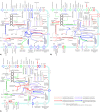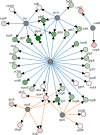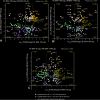Comparison of Transcriptional Responses and Metabolic Alterations in Three Multidrug-Resistant Model Microorganisms, Staphylococcus aureus ATCC BAA-39, Escherichia coli ATCC BAA-196, and Acinetobacter baumannii ATCC BAA-1790, on Exposure to Iodine-Containing Nano-micelle Drug FS-1
- PMID: 33727401
- PMCID: PMC8547003
- DOI: 10.1128/mSystems.01293-20
Comparison of Transcriptional Responses and Metabolic Alterations in Three Multidrug-Resistant Model Microorganisms, Staphylococcus aureus ATCC BAA-39, Escherichia coli ATCC BAA-196, and Acinetobacter baumannii ATCC BAA-1790, on Exposure to Iodine-Containing Nano-micelle Drug FS-1
Abstract
Iodine is one of the oldest antimicrobial agents. Until now, there have been no reports on acquiring resistance to iodine. Recent studies showed promising results on application of iodine-containing nano-micelles, FS-1, against antibiotic-resistant pathogens as a supplement to antibiotic therapy. The mechanisms of the action, however, remain unclear. The aim of this study was to perform a holistic analysis and comparison of gene regulation in three phylogenetically distant multidrug-resistant reference strains representing pathogens associated with nosocomial infections from the ATCC culture collection: Escherichia coli BAA-196, Staphylococcus aureus BAA-39, and Acinetobacter baumannii BAA-1790. These cultures were treated by a 5-min exposure to sublethal concentrations of the iodine-containing drug FS-1 applied in the late lagging phase and the middle of the logarithmic growth phase. Complete genome sequences of these strains were obtained in the previous studies. Gene regulation was studied by total RNA extraction and Ion Torrent sequencing followed by mapping the RNA reads against the reference genome sequences and statistical processing of read counts using the DESeq2 algorithm. It was found that the treatment of bacteria with FS-1 profoundly affected the expression of many genes involved in the central metabolic pathways; however, alterations of the gene expression profiles were species specific and depended on the growth phase. Disruption of respiratory electron transfer membrane complexes, increased penetrability of bacterial cell walls, and osmotic and oxidative stresses leading to DNA damage were the major factors influencing the treated bacteria.IMPORTANCE Infections caused by antibiotic-resistant bacteria threaten public health worldwide. Combinatorial therapy in which antibiotics are administered together with supplementary drugs improving susceptibility of pathogens to the regular antibiotics is considered a promising way to overcome this problem. An induction of antibiotic resistance reversion by the iodine-containing nano-micelle drug FS-1 has been reported recently. This drug is currently under clinical trials in Kazakhstan against multidrug-resistant tuberculosis. The effects of released iodine on metabolic and regulatory processes in bacterial cells remain unexplored. The current work provides an insight into gene regulation in the antibiotic-resistant nosocomial reference strains treated with iodine-containing nanoparticles. This study sheds light on unexplored bioactivities of iodine and the mechanisms of its antibacterial effect when applied in sublethal concentrations. This knowledge will aid in the future design of new drugs against antibiotic-resistant infections.
Keywords: Acinetobacter baumannii; Escherichia coli; Staphylococcus aureus; antibiotic resistance; iodine; nano-micelle; transcriptomics.
Copyright © 2021 Korotetskiy et al.
Figures




Similar articles
-
The Effect of Three Complexes of Iodine with Amino Acids on Gene Expression of Model Antibiotic Resistant Microorganisms Escherichia coli ATCC BAA-196 and Staphylococcus aureus ATCC BAA-39.Microorganisms. 2023 Jun 29;11(7):1705. doi: 10.3390/microorganisms11071705. Microorganisms. 2023. PMID: 37512878 Free PMC article.
-
The Effect of Iodine-Containing Nano-Micelles, FS-1, on Antibiotic Resistance, Gene Expression and Epigenetic Modifications in the Genome of Multidrug Resistant MRSA Strain Staphylococcus aureus ATCC BAA-39.Front Microbiol. 2020 Oct 22;11:581660. doi: 10.3389/fmicb.2020.581660. eCollection 2020. Front Microbiol. 2020. PMID: 33193215 Free PMC article.
-
Transcriptomics and methylomics study on the effect of iodine-containing drug FS-1 on Escherichia coli ATCC BAA-196.Future Microbiol. 2021 Sep;16:1063-1085. doi: 10.2217/fmb-2020-0184. Epub 2021 Sep 1. Future Microbiol. 2021. PMID: 34468178
-
Update on Pseudomonas aeruginosa and Acinetobacter baumannii infections in the healthcare setting.Curr Opin Infect Dis. 2005 Aug;18(4):306-13. doi: 10.1097/01.qco.0000171920.44809.f0. Curr Opin Infect Dis. 2005. PMID: 15985826 Review.
-
New antibiotic agents: problems and prospects.Surg Infect (Larchmt). 2005;6 Suppl 2:S-97-107. Surg Infect (Larchmt). 2005. PMID: 23577500 Review.
Cited by
-
The Effect of Three Complexes of Iodine with Amino Acids on Gene Expression of Model Antibiotic Resistant Microorganisms Escherichia coli ATCC BAA-196 and Staphylococcus aureus ATCC BAA-39.Microorganisms. 2023 Jun 29;11(7):1705. doi: 10.3390/microorganisms11071705. Microorganisms. 2023. PMID: 37512878 Free PMC article.
-
Nanotherapies based on bacterial metabolism: Mechanisms, design and application.Mater Today Bio. 2025 Jul 18;34:102117. doi: 10.1016/j.mtbio.2025.102117. eCollection 2025 Oct. Mater Today Bio. 2025. PMID: 40735698 Free PMC article. Review.
References
-
- Abraham EP, Chain E, Fletcher CM, Florey HW, Gardner AD, Heatley NG, Jennings MA. 1992. Further observations on penicillin. 1941. Eur J Clin Pharmacol 42:3–9. - PubMed
-
- Nicolaou KC, Montagnon T. 2008. Molecules that changed the world. Wiley-VCH, Weinheim, Germany.
LinkOut - more resources
Full Text Sources
Other Literature Sources
